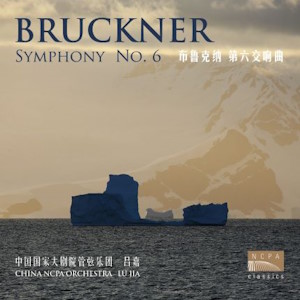
Anton Bruckner (1824-1896)
Symphony No. 6 in A major, WAB 106 (ed. Nowak)
China NCPA Orchestra/Lü Jia
rec. live composite, 9-11 January 2024, China NCPA Concert Hall, Beijing
NCPA Classics 81620208-1 [59]
This is the latest individual issue of what will be a box set of nine Bruckner symphonies due to be released on 22 December 2024. I have previously very favourably reviewed the first six here and this maintains the high standard set by its predecessors.
Its timing is what might be termed “conventionally slow”; nothing excessive or unusual, in keeping with the cycle as a whole so far. The opening, however, seems in the first instance quite spritely for “Majestoso” – but then the explosive tutti 51 seconds in negates any sense of levity and from then on there is a determined sense of purpose about Lü Jia’s direction; the sheer amplitude of the orchestral sound generated here and the sense of forward momentum sweep the listener along, such that even the quasi-pastoral interludes with flute arpeggios sound vaguely menacing. The martial brass chorale is magnificently played, soaring above the insistent, sawing string underlay and the recording balance permits us to hear everything going on in the music; the sound quality is excellent. Rather than taking “Bedeutender langsamer” (significantly slower) too literally, Lü Jia – correctly, I think – interprets this as demanding that he invest the progress of the music with even more grandeur, and slows down only marginally for the final section while maintaining tension; the coda is electrifying.
The Adagio is predictably steady – not, by any means, one of the slowest on record but measured and reverential, the Gesangsperiode blooming gratifyingly and treated to some telling dynamic shading – but always shot through with the same menace and melancholy present in the first movement and which haunt this, the most unusual and ambivalent of Bruckner’s symphonies. There is nothing pusillanimous or reserved about Lü Jia’s interpretative stance here; he lets his players off the leash to sing “in full-throated ease”, applying rubato freely then winding down to a serene conclusion.
The Scherzo is a little slow and dogged for my taste but again, the weight of orchestral sound is mightily impressive and this approach is consistent with Lü Jia’s treatment of the symphony as a whole. The Trio does not bring much “light relief” but has instead more a sense of “the calm before the storm” and the conclusion is positively dangerous-sounding. That mood is continued into the restless finale; the brass blasts here are so much more minatory than in Rattle’s LSO Live account and there is a real sense of a cosmic conflict between opposing forces, as the lyrical second theme struggles to assert itself over the brutal, blazing march before the coda drives towards a triumphant – or is it? – A major conclusion. It would have been a thrill to have been present in the audience for this performance but there is no indication of this being live and no applause is included.
Once again, the NCPA orchestra delivers a thoroughly satisfying account of a Bruckner symphony; this set is proving to be one of the highpoints of the bicentenary.
Ralph Moore
Availability, including complete set of nine symphonies: Sunrise Music


















